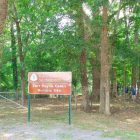Fort Payne Cabin Site
Fort Payne Cabin Site
Location: At the east end of 4th Street SE (just east of Gault Avenue S), Fort Payne
Telephone: (256) 845-6888 (Landmarks of DeKalb Company, site owner)
Access: Open to the public by appointment

Historical Significance: In 1837 federal troops arrived in Wills Valley to establish a fort to remove the Cherokee Indians from the area. The cabin site is part of local property seized by the military for Fort Payne, one of over 20 removal forts (stockades) established in Alabama, Georgia, and North Carolina. Principal Chief John Ross and other leaders had lost their political and judicial battles with The United States and the Cherokee would be forced to leave their homeland in Northeast Alabama, as part of what’s now known as the Trail of Tears. To accommodate officers, soldiers, Cherokees, supplies and animals, the local property included a fort, water supply (the Big Spring), holding pens, cabins, encampment areas and associated outbuildings. Some structures were built specifically for the compound, while others, owned by the Cherokee, were confiscated for use as part of the fort.

Research indicates the cabin belonged to Cherokee John Huss (Spirit the Preacher), and was built circa 1825. Historical documents show that Cantonment Payne existed as early as fall 1837, became Fort Payne by December 1837, and was a major emigrating depot by the fall of 1838. The majority of Cherokee who were forced by the military to leave their homes in Alabama left from Fort Payne. A detachment led by Cherokee John Benge departed for Indian Territory in October of 1838, and the fort was closed soon after. Although the fort was used for only about a year, the cabin continued in use until the mid 1940s. Today a chimney, the cabin foundation, and a nearby stacked stone well remain.
